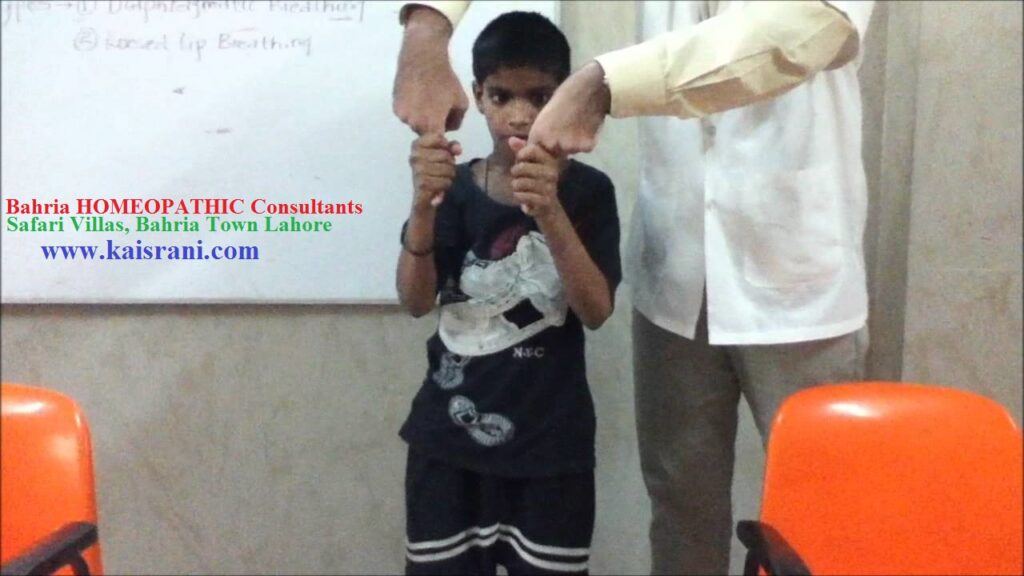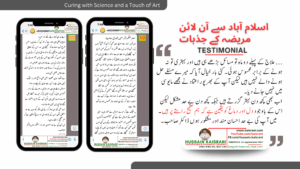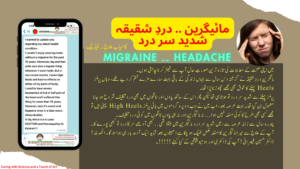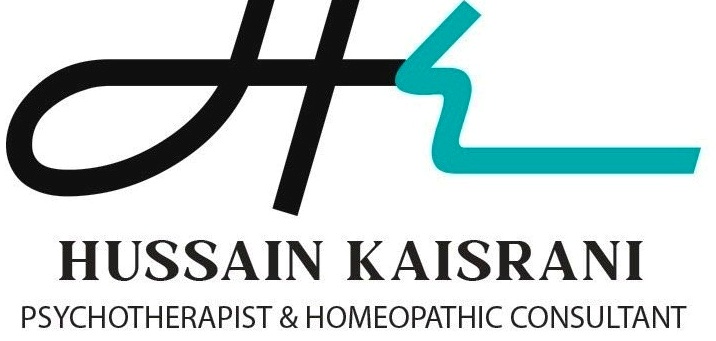For reading in Urdu, please Clink on Following link:
رعشہ – ہومیوپیتھک علاج – حسین قیصرانی ،Huntington’s Chorea, Chorea
Homeopathic Treatment of Chorea
Chorea is an abnormal involuntary movement derived from the Greek word “dance”. It is characterized by brief, abrupt, irregular, unpredictable, non-stereotyped movements. In milder cases, they may appear purposeful; the patient often appears fidgety and clumsy. They can affect various body parts, and interfere with speech, swallowing, posture and gait. Chorea may worsen with anxiety and voluntary movements, and subsides during sleep. Chorea is characterized by brief, semi-directed, irregular movements that are not repetitive or rhythmic, but appear to flow from one muscle to the next.
These ‘dance-like’ movements of chorea often occur with athetosis, which adds twisting and writhing movements. Walking may become difficult, and include odd postures and leg movements.
Unlike ataxia, which affects the quality of voluntary movements, or Parkinsonism, which is a hindrance of voluntary movements, the movements of chorea and ballism occur on their own, without conscious effort. Thus, chorea is said to be a hyperkinetic movement disorder.
When chorea is serious, slight movements will become thrashing motions; this form of severe chorea is referred to as ballism or ballismus.
Causes
- Chorea can occur in a variety of conditions and disorders.
- Chorea is a primary feature of Huntington’s disease, a progressive neurological disorder.
- Twenty percent (20%) of children and adolescents with rheumatic fever develop Sydenham’s chorea as a complication.
- Chorea gravidarum is rare type of chorea which is a complication of pregnancy.
- Chorea may also be caused by drugs (levodopa, anti-convulsants, anti-psychotics), metabolic disorders, endocrine disorders, and stroke.
- Wilson’s disease, a genetic disorder that leads to toxic levels of copper in the body
- Transmissible spongiform encephalopathy’s: A group of neurodegenerative diseases such as Creutzfeldt-Jakob disease and Kuru, caused by prions.
- Neuroacanthocytosis, a genetic disorder that may affect the blood, brain, peripheral nerves, muscle and heart. Common features include peripheral neuropathy, cardiomyopathy and hemolytic anemia. Other features include limb chorea, facial tics, other oral movements (lip and tongue biting), seizures, a late-onset dementia and behavioral changes.
Symptoms
- Swelling and inflammation (arthritis) of one or more joints that may be characterized by redness, warmth, tenderness, and pain (arthralgia) of affected joint regions. Arthritis and fever are the most common symptoms initially recognized in association with ARF.
- Symptoms of muscular twitching, among which are twitching and spasms of the eyeballs and eyelids; it has angular choric movements and spasmodic motions of the extremities, which are not confined to one side of the body, but affect the upper half on one side of the body and the lower half on the other.
- Symptoms may appear gradually or suddenly, and may include muscle weakness, hypotonic (decreased muscle tone), and clumsiness. The symptoms vary in severity–from mild cases in which there is restlessness, facial grimacing, and a slight degree of in-coordination of movements, to severe cases involving involuntary movements that incapacitate the child.
Homeopathic Treatment of Chorea:
Chorea can be easily managed by homeopathic medicines.
Homeopathic treatment of chorea
Homeopathy is one of the most popular holistic systems of medicine. The selection of remedy is based upon the theory of individualization and symptoms similarity by using holistic approach. This is the only way through which a state of complete health can be regained by removing all the sign and symptoms from which the patient is suffering. The aim of homeopathy is not only to treat chorea but to address its underlying cause and individual susceptibility. As far as therapeutic medication is concerned, several remedies are available to cure chorea that can be selected on the basis of cause, sensations and modalities of the complaints. For individualized remedy selection and treatment, the patient should consult a qualified homeopathic doctor in person. There are following remedies which are helpful in the treatment of chorea:
Tarantula Hisp – chorea major with necessity for continual motion; trembling of whole body; movements irregular and violent, sometimes cannot speak, swallow, sit, stand or walk, but must constantly lie down; motions especially affect right arm and left leg; nocturnal chorea, contractions not ceasing even at night; sometimes only right side affected; can run better than walk; vertigo and fainting; oppression in cardiac region; anxiety and fear of impending death; contraction and painful rigidity of some muscles; aggravation from pressure and touch; amelioration from diversion, especially music; feels best in bed.
Veratrum Vir – chorea megna with extremely severe convulsive action; most violent distortions of the body; universal, unaffected by sleep; lips covered with foam; inability to swallow; waked up by continual champing and prattling of unintelligible words, followed by sleep; intense sexual excitement; convulsions like electric shocks, opisthotonos
Zincum met – chronic chorea, aggravation after dinner, towards evening, after drinking wine and during rest; great depression of spirits; twitching in various muscles; whole body jerks during sleep; starting and rolling from side to side on waking; cries out as if frightened; feet fidigity and constantly moved while in bed; aggravation from exercise; chorea much affecting the general health, caused by fright or suppressed eruptions.
Thuja – sycosis, craving appetite; hair dry; soreness of corners of mouth; ill -humored and obstinate; laughs without cause; violent spasmodic twitching and prattling of unintelligible words, followed by sleep.
Stramonium – mania saltatoria; movements characterized by great violence and affecting the parts of body corrosive, or more the upper extremities, or isolated groups of muscles, or affecting the whole body, producing the most grotesque leaps, motions and gestures, rotates arms, clasps hands over head, full of fear, strange and inconsistent fancies; motion all rapid, runs as fast as possible; attacks preceded by formication of limbs and melancholy; diplopia; aggravation at night, in dark place or dark room, during equinoxes, after fright or care. It may finally lead to idiocy.
Sepia – convulsive motions of head and limbs; when talking jerking of facial muscles; general muscular agitation; desire to change constantly place and position. Ringworm like eruptions on skin every spring; uterine chorea with menstrual irregularities; amelioration after menses and after a thunderstorm
Silicea – verminous irritation; especially from ascarides; distorted eyes, pale face, canine hunger, irritation, irritation of nostrils, constitution; oedema of face and extremities, great thirst; sleep disturbed by frightful dreams; foot-sweat of disagreeable odor.
Sticta pul – chorea complicated with hysteria, movements confined to lower extremities, aggravation evening; feet and legs jump and dance about in spite of the efforts to prove them; sensation as if the legs were floating in the air when lying down.
Secale cor – spasmodic twitching beginning in the muscles of face and spreading over whole body, sometimes increasing or jumping and dancing; distortions or either a frightful or ludicrous character; spasms attack muscles of chest and diaphragm; causing loss of breath; spasm worst when affecting abdominal muscles and painful; convulsive starts, with the fingers spread out.
Nux Vomica – spinal chorea, with sensation of numbness in affected muscles; crawling sensation in affected parts; unsteady gait; feet drag; movements renewed by the least touch, but relieved by firm, steady pressure; poor appetite, constipation; aggravation in the morning, from high living
Opium – emotional chorea; trembling the head, arms and hands; arms are thrown out at right angles with the body and spasmodic jerking of the flexors; convulsive movements of one or other arm to and fro; twitching continue during sleep.
Asafoitida – chorea on account of nervous disorder; action of the muscles; pain and numbness
Zincum phos – in worn-out and weak patients; worse by cold
Causticum – when right side is more affected than the left; the muscles of the face, tongue, arms and legs are all involved; words are jerked out when talking. Patient continually changes position until he falls asleep exhausted; children who have learnt to walk fall easily, clumsy in their gait.
Actea racemosa – for spinal irritation with rheumatism mostly in females at the time of puberty and the menopause; going crazy, talkative; Frequently changing from one subject to another; Jerking of the muscles when in a state of emotion or from becoming chilled; jerking of the side of lain on or the parts pressed; numbness and jerking of the muscles
Tissue Salts by Schussler
Calcarea phos
In scrofulous children. Chorea during puberty in either boys or girls who are deficiently developed.
Magnesia phos
This is the chief remedy. Involuntary movements and contortions of the limbs, with mute, appealing looks for sympathy. It is especially a remedy in local choreas, such as occupation spasms, writer’s cramps, piano and violin players’ spasms, etc. Follow or alternate with Calcarea phos.
Silicea
When due to the presence of worms, spasms, sleep disturbed by frightful dreams, distorted eyes, pale face; canine hunger, irritation of nostrils, constipation, great thirst, cedema of face and extremities.
Natrum mur
Suitable for chronic cases, after fright or suppression of eruptions on the face, paroxysms of jumping regardless of obstructions, twitchings on the right side, worse at full moon, especially in malarial, anaemic and chlorotic states, with thirst and fever.
Natrum phos
If due to worms, or if acid symptoms are present. (See Silicea.)
CLINICAL CASES
Cases of chorea; face and upper part of body affected; lateral and downward jerking of the mouth, snapping of eyelids, sudden forward motion of head, and other irregular movements. Better during sleep; aggravated at stool and by emotions, Ignat. failed. Magnesia phos for three months produced gratifying results, but did not fully cure. Acting on Dr. Schussler’s advice, Calcarea phos. 6x was given alternately with Magnesia phos., the former once daily, the latter twice. In one month the child was cured. (D. B. Whittier, M. D.)
Choreic patient talking to herself constantly, or sitting still in moody silence, or carrying things from one place to another and then back again. Magnesia phos.” cured. (Dr. Sager.)
H. S., set. 7. Chorea for two years, caused by fright; pale, delicate, anaemic, drinks mufch water, feverish, white tongue, sore mouth. Natrum mur. cured permanently. (C. P. Hart, M. D.)
CHOREA CURED BY MAGNESIA PHOS
(By Dr. John H. Clarke). Gertrude S , aet. 6, was admitted to the London Homeopathic Hospital, on March 30th, 1887. She had suffered from well-marked chorea during the preceding eight months, and the usual remedies for such conditions had been administered to her as an out-patient during the previous two months with but small success. No definite cause was to be made out. The child did not suffer from worms, and there was no history of a fright. On admission she twitched all over during her waking hours, but was quiet during sleep. She walked fairly well and could feed herself, but her speech was exceedingly defective. The heart’s action was accelerated, but no abnormal sound was to be distinguished. Subsequently, however, a soft, presystolic, blowing sound was at times audible, as if the muscular fibres of the heart participated in the general spasms. The pupils were symmetrically dilated. Magnesia phos. was prescribed — two grains of the sixth decimal trituration, three times daily. The improvement which followed was slow, but abundantly manifest. The general twitching became less; the articulation improved, the. child took nourishment freely; slept well at night, and lost the scared expression so characteristic of the complaint. By May 17th no vestige of the chorea remained. On being directed to stand up, close the eyes, and hold the arms extended, she did so without difficulty. Subjected to the difficult test of walking blindfolded, she came through triumphantly. Lastly her powers of speech had so much improved that, whereas oh her admission the meaning of her utterances was a matter of pure conjecture, by this date her remarks were quite intelligible. Thus within seven weeks this obstinate case of a very troublesome disease yielded completely to Magnesia phos. one of Schussler’s so-called “tissue remedies.” No other medicine was given (Horn. World, July, 1887).
Reference
- Blueprints clinical cases neurology; Kevin Sheth, Odette A. Harris, Tracey A. Cho, Aaron B Caughey; 2006; 42
- Neuroacanthocytosis Syndromes II, Volume 2; Ruth H. Walker, Shinji Saiki, Adrian Danek; 2008; 22
- Principles and Practice of Emergency Neurology: Handbook for Emergency …; Sid M. Shah, Kevin M. Kelly; 2003; 152
- Principles and Practice of Emergency Neurology: Handbook for Emergency …; Sid M. Shah, Kevin M. Kelly; 2005; 151
- In a page: Signs & symptoms; Scott Kahan; 2004; 33
- Homoeopathic Therapeutics; Samuel Lilienthal; 1998; 195-198.
- Select your remedy; Rai Bahadur Bhishambar Das; 2007; 64, 65
- Illustrated guide to the homeopathic treatment; Dr. H.S Khaneja; 2010; 147
- George Vithoulkas lectures






